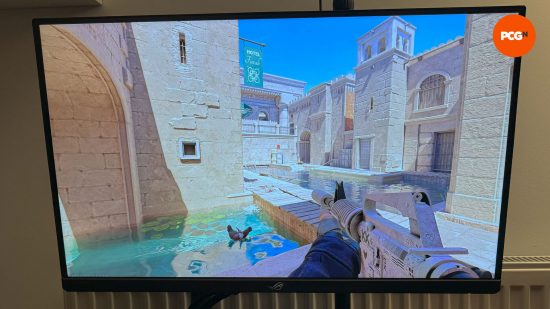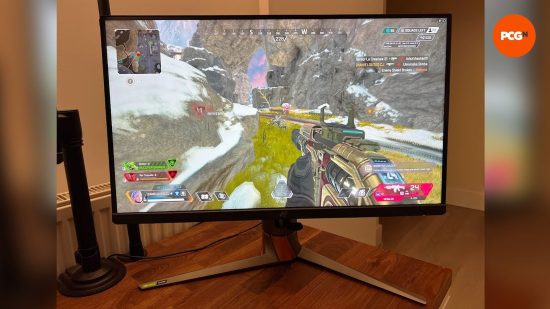After weeks of intensive testing, we’re able to share our closing verdict in our Asus PG27AQN assessment. 24-inch 1080p shows with 240Hz refresh charges have been the usual in most esports for years now, however the Asus PG27AQN is threatening to alter that. Coming in at $1,049.00 / £1,098.98, it’s undoubtedly not one for the price range gamer, however for those who’re after the perfect in efficiency, you’d be hard-pressed to discover a worthy competitor.
The PG27AQN is each bigger and sooner than its predecessors with a 27-inch 1440p 360Hz IPS show, and now it comes with a game-changing characteristic: Nvidia G-Sync ULMB 2. Extremely Low Movement Blur 2 guarantees to ship “over 1,000Hz of efficient movement readability”, which boils right down to a clean, tear-free picture with out sacrificing brightness this time round.
Get gaming gear for much less ☞ Our free money-saving software finds reductions for you at over 40,000 on-line retailers. Try PCGamesN Deal Finder now.
ROG Swift 360Hz PG27AQN design
If you happen to’ve seen an Asus ROG monitor over the previous 5 years, this show’s design shouldn’t come as a shock to anybody. The PG27AQN sports activities ultra-thin bezels alongside the edges, with a surprisingly thick chin that includes the ROG branding entrance and heart. Asus sticks with its staple ROG design for the rear paneling with a big RGB emblem and circuitry-style end. You’ll additionally discover 4 buttons and a mini stick to regulate the monitor’s settings spherical again.
Within the field, you’ll additionally discover Asus’ acquainted tripod stand, though this time it solely extends by 100mm. This offers the monitor a real ‘esports really feel’—the place the prime angle requires you to virtually lean over the monitor, tilting it upwards in the direction of your face—nevertheless it’s not essentially for the higher. If you happen to plan to place this like a daily monitor, the stand leaves little or no room on your keyboard and mouse. Thankfully, the monitor comes geared up with a 100mm x 100mm VESA mount, providing you with the choice to position the show on a monitor arm for higher ergonomics.
Asus is attempting to make a daring assertion with this monitor: esports players can lastly transfer on from their previous shows. But the design of the PG27AQN doesn’t replicate that in any respect. Once more, this design has been used for years, and it’s beginning to present its age in comparison with not too long ago launched displays like Dough’s Spectrum One and Dell’s UltraSharp U2723QE. Understandably, there’s solely a lot you are able to do with a display, however we really feel Asus might’ve tried tougher to create a brand new monitor design that matches its premium price ticket.
ROG Swift 360Hz PG27AQN specs
The Asus ROG Swift 360Hz PG27AQN is among the first 27-inch 2560×1440 displays with a 360Hz max refresh charge. Full with G-Sync help and 400 nits peak brightness (SDR), this is among the brightest gaming displays I’ve ever used, particularly when utilizing its esports mode which takes full benefit of its further nits and makes the colours extra vibrant.
Listed here are the Asus ROG Swift 360Hz PG27AQN specs:
| Display measurement | 27-inches |
| Decision | 2560 x 1440 |
| Refresh Charge | 360Hz |
| Panel Kind | IPS |
| Peak brightness | 400cd/㎡ (SDR) 600 cd/㎡ (HDR) |
| Connectivity | DisplayPort 1.4 (x1) HDMI 2.0 (x3) USB 3.2 Gen 1 Kind-A (x2) 3.5mm audio out |
At this value level, we might’ve favored Asus to incorporate the most recent ports like USB-C (DP Alt) as an possibility for individuals utilizing laptops or different gadgets that make the most of Kind C ports. It’s not a deal breaker by any means, however we’d a lot somewhat sacrifice one HDMI port if it meant our different gadgets might connect with the show with no need any adapters.
ROG Swift 360Hz PG27AQN efficiency
The star of the present is well ULMB 2, which solely arrived in Could 2023 through a firmware replace. This characteristic lowers the brightness to a minimal of 250 nits and virtually eliminates movement blur, leaving crystal-clear frames. I’ve been utilizing a 240Hz 1440p monitor (the Alienware AW2721D) for a couple of years now, and I’m conscious that as you transcend 144Hz, the extra you’re more likely to expertise diminishing returns. Whereas I used to be impressed with the leap between 240Hz to 360Hz, it wasn’t till I attempted ULMB 2 that the gulf between the 2 displays was uncovered.
I discovered this impact was instantly noticeable in CS:GO and CS2, each of which I’ve no downside working at 360fps on my setup. You’ll spot the distinction ULMB 2 makes inside seconds of switching it on because it utterly removes the blurry trails objects depart behind when you’re shifting (because of it flashing the backlight on and off, lowering eye-tracking movement blur and masking sluggish LCD response time). It virtually appears like that scene in Spider-Man 1 when Peter Parker realizes he doesn’t want glasses anymore. It sounds a bit dramatic however after I say that is an absolute game-changer, I actually imply it. After I first took the monitor out of the field, I used to be impressed with what felt like a comparatively small leap from 240Hz to 360Hz, however ULMB 2 pushes it into completely new territory for aggressive esports tech.
If you happen to’re critical about constructing the last word setup with the least quantity of lag attainable, Nvidia’s Reflex Analyzer software is constructed into the PG27AQN, offering you with data on how a lot lag you’re coping with. So long as you’re utilizing a appropriate mouse (my testing was carried out utilizing an Asus ROG Harpe Ace) you may take a look at your mouse latency, PC + show latency, and system latency in actual time to evaluate any bottlenecks in your setup. As you may count on, while you mix a top-tier gaming mouse just like the ROG Harpe Ace with a low-latency show, you’re going to have a good time.
Although the PG27AQN boasts good SDR brightness, there’s not a lot to say concerning the show’s HDR capabilities. Sure, it’s technically licensed for HDR 600, however this isn’t something to rave about with solely 24 dimming zones. To be truthful, this isn’t what most individuals are buying the monitor for, simply don’t count on this show to carry out miracles with reference to HDR gaming because it wasn’t constructed for the sort of expertise.
The PG27AQN additionally comes with a singular characteristic that lets you play your video games utilizing an unorthodox decision of 2368 x 1332, shrinking the display measurement right down to a cool 25”. This leaves a small black bezel across the show, however the result’s a sharper picture than you’d see at 1080p, providing you with the advantages of a smaller show with out having to compromise on image high quality. That being stated, for those who’ve received a beefy laptop that may run esports titles at 360Hz, you most likely received’t want to make use of this characteristic except you’re desperately attempting to realize the next body charge.
Is the ROG Swift 360Hz PG27AQN price it?
In relation to competing on the highest degree, you’re going to need to acquire each benefit you may get. If you happen to can abdomen dropping over $1,000 on a monitor, the Asus ROG Swift 360Hz PG27AQN is undoubtedly well worth the money. Packing one of many brighter SDR shows we’ve seen and implementing ULMB 2 to realize superior movement readability, the PG27AQN is troublesome to beat.
Options reminiscent of its esports dual-mode and help for NVIDIA Reflex Analyzer assure you’ll by no means must blame your {hardware} while you whiff a shot. It doesn’t matter what sort of esports you’re into, you received’t discover a monitor extra suited to the duty than the PG27AQN.
Up till now, the very best gaming shows for esports have all the time featured some kind of compromise, whether or not or not it’s decision or show lag. The Asus ROG Swift 360Hz PG27AQN exhibits us what the subsequent few years of esports might appear like, lastly permitting aggressive gamers to get pleasure from the very best of each worlds with out having to make any sacrifices.
- ULMB 2 is a gamer changer
- Constructed-in Nvidia Reflex Analyzer
- Nice SDR brightness
- Costly
- No USB-C DP Alt. port
- Not an enormous improve for present 240Hz house owners







Comments are closed.